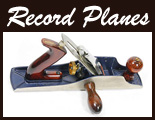The Howkins Plane
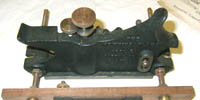 As anyone who has collected or used hand planes for a few years knows, the hand plane world is full of many oddities. Planes that probably should never have seen the light of day due to poor design, poor marketing or a combination of both sit alongside other planes so ingeniously designed and innovative for their time that it’s hard to understand why their sales didn’t shoot through the roof. In the case of metal planes the manufacturers would try to convince the woodworking public that grooves and squiggly lines milled into the soles would make the plane perform better, just as strips of rosewood, circular discs and even open holes similarly milled into the bases would also help to improve performance. Oilers, weird adjusters, two-part bodies, swivelling frogs and zero-bedded blades all came and quickly went in the pursuit to sell more hand planes to the public. Although it makes for an interesting and colorful history its pretty safe to say that many of these makers were doomed to fail long before they even started.
As anyone who has collected or used hand planes for a few years knows, the hand plane world is full of many oddities. Planes that probably should never have seen the light of day due to poor design, poor marketing or a combination of both sit alongside other planes so ingeniously designed and innovative for their time that it’s hard to understand why their sales didn’t shoot through the roof. In the case of metal planes the manufacturers would try to convince the woodworking public that grooves and squiggly lines milled into the soles would make the plane perform better, just as strips of rosewood, circular discs and even open holes similarly milled into the bases would also help to improve performance. Oilers, weird adjusters, two-part bodies, swivelling frogs and zero-bedded blades all came and quickly went in the pursuit to sell more hand planes to the public. Although it makes for an interesting and colorful history its pretty safe to say that many of these makers were doomed to fail long before they even started.
A lot of these hand planes were invented and developed in America from the mid to late 1800’s and into the early 1900’s. Even Stanley Planes – the giant of the metal hand plane world – had several models which left the tool collecting world wondering “Why?” One thing is certain though, almost invariably these rarer planes, whether made by Stanley or other makers, can command very high prices at the auction houses and internet sales around the world. Not many people will get to see them “in the flesh” as it were — unless of course they have money to burn!
Enter The Howkins…
However, not all of the “weirdo” planes originated from America. One of these “plane oddities” was the Howkins plane, which was made in small numbers in England from the 1920’s and into the 1930’s. While its not known exactly where in England the planes were made, its assumed by some collectors that they originated from somewhere in London. Certainly its known that the instruction books which accompanied the planes were printed in Kingsway as its printed as such on the brochures.
Described and marketed as a multipurpose plough plane, the makers claimed it could do a variety of jobs that other similar planes at the time might struggle with. While its true that the Howkins plane can do a multitude of different work, albeit with some degree of difficulty with setting up and actual use, some of the jobs erroneously claimed by the company seem a little far-fetched.
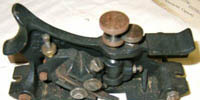 LEFT: The Model C Howkins Plane.
LEFT: The Model C Howkins Plane.
The basic design for the Howkins Plane was patented in 1913 and the first production model appeared around seven years later, in 1920. It’s conceivable that the patent and the arrival of the first production model was delayed due to the onset of the First World War. As it proved a difficult time for many planemakers this would be feasible.
This first Howkins plane was known as the Model A. It had a limited production run of only fifty planes and each one of them was supposedly numbered. In 1925 a more sophisticated model appeared, known as the Model B and a few more years after that the Model C arrived (featuring a much wider range of functions supposedly). A final model was produced after that, known as the Model D. Apparently it is believed that the last plane allowed some interchangeability of parts between the B and C models. While the Model A had a body cast of gunmetal the B, C and D model planes all have cast iron bodies.
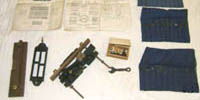 RIGHT: Cutters, fences, spanner and instruction manual.
RIGHT: Cutters, fences, spanner and instruction manual.
The body casting is quite nicely done on the examples I’ve seen, being fairly crisp and clean. The plane has an interesting way of adjusting the depth of cut. The blade is held in a special tool holder, which is also fitted with a spur cutter, and then lowered by a feed screw. Likewise the cutter holder is very well made and the cutters themselves are nicely finished. The feed screw for the cutter depth uses a very fine thread, and the adjustment for the backlash is also made quite well.
Unfortunately however, thats where the build quality ends, as the rods for the fences and the fence itself are rather poorly done. In fact the rods themselves appear to be as if someone has just cut off a couple of lengths of 1/4″ Whitworth all-thread and screwed them into the body. Nothing much to write home about at all and, according to W.L. Goodman in his book “British Planemakers From 1700”, the arrangement is described as being “an engineer’s conception of a woodworking tool, being finely made but with less well designed fences and stems”
The fence adjustment is done by using ordinary hexagon nuts which have washers on each side. Although the plane was sold with a spanner provided, the process of adjusting the fence is very time consuming. The whole setup lacks the convenience of knurled or specially designed nuts or thumbscrews found on similar planes. It’s a shame as this would greatly improve the usability of the plane.
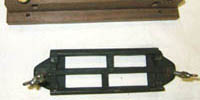 LEFT: Some of the cutters. Notice the “two-pronged” cutters used for dado cutting.
LEFT: Some of the cutters. Notice the “two-pronged” cutters used for dado cutting.
Although the body itself is unusually shaped, the plane is surprisingly very comfortable to use. Somehow or another it seems to fit into the hand quite well, and any backlash in the feed screw is eliminated by adjusting the lower of the two knurled knobs, which can be locked using a locknut.
As to be expected all four models of the Howkins Plane had their own differences and idiosyncrasies. The Model C was apparently modified so that the threaded fence rods were placed approximately 2″ further apart and were able to extend through the body to allow a fence to be attached on either side. It should also be noted that the body casting is longer by about two inches or so. One of the two fences supplied had a small attachment with 1/8″ holes which could be used as pivot points for circular work – albeit limited. A wood screw was used as the fulcrum point for this operation, and fence rods up to 12″ long were available. As circular cutting involves both long and cross grain, a a custom “spurred double cutting iron” was necessary.
Each of the models were supplied with a basic set of cutting irons for plough work, but a wide range of cutters were available to buy separately as extras to suit particular needs. These included five plough irons from 1/8″ to 11/32″, six dado tools (with spurs) for cross-grain working, four moulding cutters (two beads and two hollows), a 3/8″ skew bevel cutter (for dovetailing) and a tool holder with five plough cutters and one beading tool.
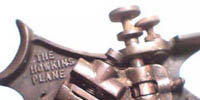 LEFT: A Model B Howkins Plane showing a close-up of the blade holder and adjustment mechanism.
LEFT: A Model B Howkins Plane showing a close-up of the blade holder and adjustment mechanism.
The dovetailing claim is interesting, and is basically only limited to making through dovetails, or dovetail housings. It takes quite a bit of effort to set the plane up for this and I doubt whether its really worth the bother. Likewise some of the claims in regards to circular and elliptical work were equally tedious to put into practice.
As there is no actual depth stop to a Howkins plane the correct depth is reached by carefully feeding the cutter down. There is also no skate so the thickness of the shaving is not regulated. This is actually quite a bonus as it allows you to take several thick cuts with the blade before finishing off with thinner cuts. As the feed screw allows for very fine adjustment, taking a thin cut is easily achievable. This feature also allows for a stopped groove to be made, if necessary.
The special tool holder with its set of six cutters is very useful. All of the cutters have a 3/16″ diameter circular shank which makes it possible to rotate the cutters in the holder. As the cutters also come in 1/16″ and 3/32″ sizes it makes this plough plane particularly useful for smaller, detailed work.
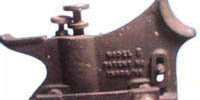 LEFT: The back of the Model B.
LEFT: The back of the Model B.
When it comes to making dadoes two cutters are used – an ordinary upper cutter (which is fitted bevel upwards), and a lower cutter which has two spurs on either side of the same width as the top cutter. This lower cutter is set so that the two points are about 1/64 of an inch below the main cutting edge. I’ve found that the arrangement seems to work fairly well for most woods that I’ve used it on.
As far as using the Howkins plane for general plough work goes… well, its a little slow to be honest. The main problem is the fence arrangement. Everything looks and works fine enough and the finished work – especially on difficult woods – is quite good. As mentioned before the tool is quite comfortable to use, so the ergonomics seem to be OK there. It’s just slow, and you might find yourself reaching for your Stanley #50 or your Record #44 before you would consider using a Howkins – that’s if you had one in the first place of course! However, if you were to only set the Howkins up for one specific ploughing job and one job only, then using the plane would be fine and possibly even faster than most other plough planes – especially if you wanted to use cutters under 1/8″ wide.
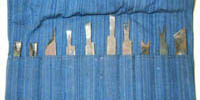 LEFT: A page featuring The Howkins Plane from the 1935 Buck & Hickman catalog.
LEFT: A page featuring The Howkins Plane from the 1935 Buck & Hickman catalog.
As far as actually buying one well it should be said that they’re not common at all, but they do occasionally turn up on eBay and antique tool auctions. As with any tool the prices vary, depending on condition, the number of cutters and the desire of the potential buyers at the time. With only 50 of them made, the Model A planes are the rarest and can command fairly high prices. Having said that though a Model A, with two cutters only, sold at auction for a mere £150 ($263) in September 1985, whereas a Model B sold for £205 ($360) at the same sale. A few months later a Model C with 13 cutters sold for £170 ($300).
Nowadays we have eBay as the major “price setter” for hand planes and, when they turn up, Howkins planes go from anywhere between $200 and $600, with an average price of around $320.
Andrew Richardson






